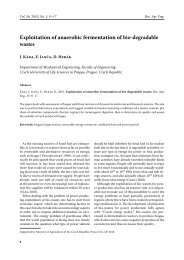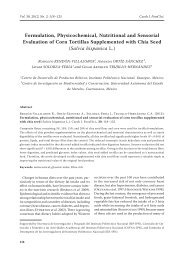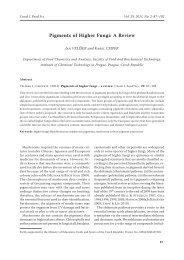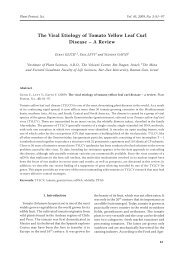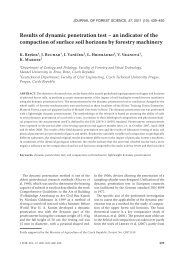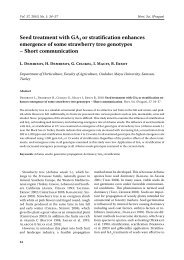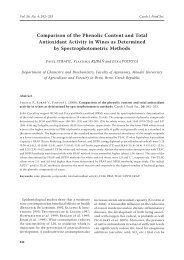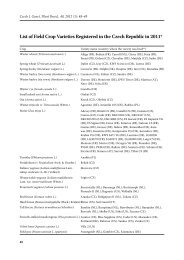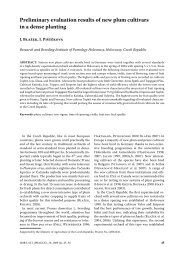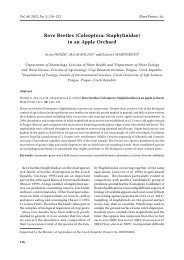Trans Fatty Acid Contents in Chocolates and Chocolate Wafers in ...
Trans Fatty Acid Contents in Chocolates and Chocolate Wafers in ...
Trans Fatty Acid Contents in Chocolates and Chocolate Wafers in ...
Create successful ePaper yourself
Turn your PDF publications into a flip-book with our unique Google optimized e-Paper software.
Vol. 28, 2010, No. 3: 177–184 Czech J. Food Sci.<br />
1992; Judd et al. 1994). In addition, there are<br />
concerns about recent suggestions that TFA may<br />
affect human fetal growth <strong>and</strong> <strong>in</strong>fant development<br />
(Ayagari et al. 1996). Also, an association exists<br />
between the prevalence of asthma <strong>and</strong> allergies<br />
<strong>in</strong> children <strong>and</strong> the risk of diabetes <strong>in</strong> adults with<br />
the <strong>in</strong>take of trans isomers (Weil<strong>and</strong> et al. 1999;<br />
Stender & Dyerberg 2004).<br />
Some research has been carried out <strong>in</strong>to TFAs<br />
<strong>in</strong> various foods worldwide (Demmelmair et al.<br />
1996; Wagner et al. 2000; Mojska et al. 2006) <strong>and</strong><br />
<strong>in</strong> Turkey (Demirbas & Yilmaz 2000; Cet<strong>in</strong> et<br />
al. 2003; Daglioglu & Tasan 2003; Karabulut<br />
2007; Basol & Tasan 2008). The most recent study<br />
concern<strong>in</strong>g trans fatty acids <strong>in</strong> Turkey reports<br />
fatty acid compositions of Turkish shorten<strong>in</strong>gs<br />
(Basol & Tasan 2008). The authors stated that<br />
partially hydrogenated vegetable oils with a high<br />
TFA content were still the major raw materials<br />
used <strong>in</strong> the production of Turkish shorten<strong>in</strong>gs.<br />
However, there is limited research (Karabulut<br />
2007) <strong>in</strong>to fatty acids composition <strong>and</strong> trans fatty<br />
acids contents <strong>in</strong> chocolates. Therefore, the objective<br />
of this study is to determ<strong>in</strong>e the fatty acids<br />
compositions <strong>and</strong> trans fatty acids contents <strong>in</strong><br />
all chocolate <strong>and</strong> chocolate wafers br<strong>and</strong>s sold <strong>in</strong><br />
Turkish markets.<br />
178<br />
MATeriAls And MeThods<br />
Sample collection. 35 samples of chocolates<br />
<strong>and</strong> 27 samples of chocolate wafers belong<strong>in</strong>g to<br />
12 different national chocolate br<strong>and</strong>s were analysed<br />
<strong>in</strong> 2007. The chocolates were categorised as<br />
milk chocolates (n = 13), bitter chocolates (n = 4),<br />
chocolates with nuts (n = 8), chocolates with pistachio<br />
(n = 3), chocolates with almond (n = 2),<br />
other chocolates (n = 5), <strong>and</strong> chocolate wafers<br />
were categorised as pure chocolate wafers (n = 14)<br />
<strong>and</strong> chocolate wafers with nuts (n = 13). Total 62<br />
samples were <strong>in</strong>vestigated, be<strong>in</strong>g all chocolate <strong>and</strong><br />
chocolate wafers br<strong>and</strong>s sold <strong>in</strong> Turkey.<br />
<strong>Fatty</strong> acid analysis. The samples of chocolates<br />
<strong>and</strong> chocolate wafers were extracted us<strong>in</strong>g the<br />
Folch et al. (1957) method. The fatty acids <strong>in</strong> the<br />
total lipid were esterified <strong>in</strong>to methyl esters by<br />
saponification with 0.5N methanolic NaOH <strong>and</strong><br />
transesterified with 14% BF 3 (v/v) <strong>in</strong> methanol<br />
(Paquot 1979).<br />
<strong>Fatty</strong> acid methyl esters (FAMEs) were analysed<br />
on a HP (Hewlett Packard, Palo Alto, USA) Agilent<br />
6890N model gas chromatograph (GC), equipped<br />
with a flame ionisation detector (FID) <strong>and</strong> fitted<br />
with a HP-88 capillary column (100 m, 0.25 mm<br />
i.d. <strong>and</strong> 0.2 µm). The <strong>in</strong>jector <strong>and</strong> detector temperatures<br />
were 240°C <strong>and</strong> 250°C, respectively. The<br />
oven was programmed at 160°C <strong>in</strong>itial temperature<br />
<strong>and</strong> 2 m<strong>in</strong> <strong>in</strong>itial time. Thereafter, the temperature<br />
<strong>in</strong>creased by 4°C/m<strong>in</strong> to 185°C, then it <strong>in</strong>creased<br />
by 1°C/m<strong>in</strong> to 200°C <strong>and</strong> was held for 46.75 m<strong>in</strong><br />
at 200°C. Total run time was 70 m<strong>in</strong>utes. Carrier<br />
gas was helium (1 ml/m<strong>in</strong>).<br />
The identification of fatty acids was carried<br />
out by compar<strong>in</strong>g the sample FAME peak relative<br />
retention times with those obta<strong>in</strong>ed for Alltech<br />
(Carolean Industrial Drive, Satate Collage, USA)<br />
st<strong>and</strong>ards. The results were expressed as FID response<br />
area relative percentages. Each reported<br />
result is the average value of three GC analyses.<br />
The results are presented as means ± SD.<br />
resulTs<br />
<strong>Fatty</strong> acids compositions <strong>and</strong> trans fatty acids<br />
contents <strong>in</strong> 35 chocolates (milk chocolates, bitter<br />
chocolates, chocolates with nuts, chocolates<br />
with pistachio, chocolates with almond, <strong>and</strong> other<br />
chocolates) <strong>and</strong> 27 chocolate wafers (pure chocolate<br />
wafers, <strong>and</strong> chocolate wafers with nuts) belong<strong>in</strong>g<br />
to 12 different national br<strong>and</strong>s obta<strong>in</strong>ed from<br />
markets <strong>in</strong> Turkey are presented <strong>in</strong> Tables 1 <strong>and</strong> 2.<br />
The TFA content varied depend<strong>in</strong>g on the chocolate<br />
<strong>and</strong> chocolate wafers groups (Table 3).<br />
Twenty five fatty acids <strong>in</strong> chocolates <strong>and</strong> chocolate<br />
wafers lipids were identified <strong>and</strong> evaluated.<br />
Palmitic acid, stearic acid, <strong>and</strong> oleic acid were<br />
high <strong>in</strong> chocolates <strong>and</strong> chocolate wafers. Oleic<br />
acid was the major fatty acids <strong>in</strong> all samples except<br />
for bitter chocolate (Tables 1 <strong>and</strong> 2).<br />
Palmitic <strong>and</strong> stearic acids were the major saturated<br />
fatty acids (SFA) <strong>in</strong> chocolates <strong>and</strong> chocolate<br />
wafers. Palmitic <strong>and</strong> stearic acids ranged between<br />
20.39–25.80% <strong>and</strong> 25.77–34.66% <strong>in</strong> chocolate<br />
groups, <strong>and</strong> 24.89–26.52% <strong>and</strong> 17.86–21.10% <strong>in</strong><br />
chocolate wafers groups, respectively (Tables 1<br />
<strong>and</strong> 2). High amounts of lauric acid were determ<strong>in</strong>ed<br />
<strong>in</strong> pure chocolate wafers (5.11%) <strong>and</strong> chocolate<br />
wafers with nuts (4.08%).<br />
Oleic acid was the major monounsaturated fatty<br />
acid (MUFA) <strong>in</strong> all samples. Oleic acid was found<br />
to amount to 43.33%, 38.49%, 36.88%, 36.39%,<br />
33.80%, 33.16%, 32.99%, <strong>and</strong> 32.31%, <strong>in</strong> chocolates




